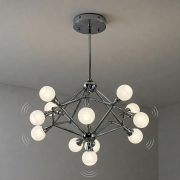Are you wondering how chandeliers came into life and into light? Well, in the old days, when chandeliers were first illuminated, they were merely for decorative art. The looks of this classy, illuminating piece are also evolving with time through the smart systems that use data and technology. It generally works to enhance our spaces beyond mere aesthetics. You may visit https://modernchandelier.com for a broader understanding of chandeliers.
From Decoration to Data Integration
Below are the historical details presenting the quick transformation of the traditional chandelier to a modern one.
Traditional Chandelier and Kinetics
Traditional chandeliers were defined and revolved around the concept of a kinetic mechanism in which there is the integration of dynamism and movement. These eventually result in the creation of continuously evolving visual spectacles.
The Data Integration of Lights
The modern chandeliers now use LED lighting to ensure energy efficiency. In addition to LED lights, moving parts are also present to create a dynamic movement of light and shadow that modifies through the movement of the chandelier itself.
Sensors and Personalized Illumination
It is important to learn about the function of sensors in lighting associated with the “data-driven design” in modern chandeliers.
Ambient Light Sensors
 This sensor works by measuring the intensity of the lights surrounding it. Natural light and artificial light present inside the room can also be detected using ambient light sensors. When this sensor changes, it creates a smooth lighting transition in a chandelier throughout the day.
This sensor works by measuring the intensity of the lights surrounding it. Natural light and artificial light present inside the room can also be detected using ambient light sensors. When this sensor changes, it creates a smooth lighting transition in a chandelier throughout the day.
Occupancy Sensors
Occupancy sensors act as detectors of the number of people occupying the space. With that concept, the chandelier automatically turns on when someone enters the room and turns off when the people leave. Thus, using this sensor is energy-saving.
Temperature Sensors
As the name implies, it measures the temperature of the air within the space. Although not as common as the first two types, this type of sensor protects the LED lights from overheating.
These sensors are a gateway for the modern chandeliers to quickly shift from a simple decoration to an integral component of smart and energy-efficient spaces. This is a result of the combination of smart control systems and algorithms.
Final Thoughts
The design and lighting functions of the chandeliers had evolved along with time and technology. From the mere purpose of being a piece of art to becoming an integral part of every cozy and classy living space, technology has engraved an essential component to the modern chandeliers that we have now through data integration. So, the next time you want to decorate and illuminate your home, try to include a modern chandelier as an illuminating artwork.
